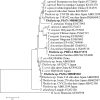Molecular detection and identification of tick-borne bacteria and protozoans in goats and wild Siberian roe deer (Capreolus pygargus) from Heilongjiang Province, northeastern China
- PMID: 31196180
- PMCID: PMC6567649
- DOI: 10.1186/s13071-019-3553-1
Molecular detection and identification of tick-borne bacteria and protozoans in goats and wild Siberian roe deer (Capreolus pygargus) from Heilongjiang Province, northeastern China
Abstract
Background: Small ruminants are important hosts for various tick species and tick-associated organisms, many of which are zoonotic. The aim of the present study was to determine the presence of tick-borne protozoans and bacteria of public health and veterinary significance in goats and wild Siberian roe deer (Capreolus pygargus) from Heilongjiang Province, northeastern China.
Methods: The occurrence of piroplasms, Anaplasma phagocytophilum, A. bovis, A. marginale, A. capra, A. ovis, Ehrlichia spp. and spotted fever group rickettsiae was molecularly investigated and analyzed in 134 goats and 9 free ranging C. pygargus living in close proximity.
Results: Piroplasm DNA was detected in 16 (11.9%) goats and 5 C. pygargus. Sequence analysis of 18S rRNA sequences identified 3 Theileria species (T. luwenshuni, T. capreoli and T. cervi). Four Anaplasma species (A. ovis, A. phagocytophilum, A. bovis and A. capra) were identified in goats and C. pygargus. Anaplasma ovis and A. bovis were detected in 11 (8.2%) and 6 (4.5%) goats, respectively; A. phagocytophilum, A. bovis and A. capra were found in 3, 7 and 3 C. pygargus, respectively. Sequence analysis of 16S rRNA sequences revealed the presence of 5 different genetic variants of A. bovis in goats and C. pygargus, while the analysis of 16S rRNA and gltA sequence data showed that A. capra isolates identified from C. pygargus were closely related to the genotype identified from sheep and Haemaphysalis qinghaiensis, but differed with the genotype from humans. Anaplasma/Theileria mixed infection was observed in 2 (1.5%) goats and 5 C. pygargus, and co-existence involving potential zoonotic organisms (A. phagocytophilum and A. capra) was found in 2 C. pygargus. All samples were negative for A. marginale, Ehrlichia spp. and SFG rickettsiae.
Conclusions: These findings report the tick-borne pathogens in goats and C. pygargus, and a greater diversity of these pathogens were observed in wild animals. Three Theileria (T. luwenshuni, T. capreoli and T. cervi) and four Anaplasma species (A. ovis, A. phagocytophilum, A. bovis and A. capra) with veterinary and medical significance were identified in small domestic and wild ruminants. The contact between wild and domestic animals may increase the potential risk of spread and transmission of tick-borne diseases.
Keywords: Anaplasma; China; Goats; Siberian roe deer; Theileria; Tick-borne pathogen; Zoonosis.
Conflict of interest statement
The authors declare that they have no competing interests.
Figures



Similar articles
-
Anaplasma capra: a new emerging tick-borne zoonotic pathogen.Vet Res Commun. 2024 Jun;48(3):1329-1340. doi: 10.1007/s11259-024-10337-9. Epub 2024 Mar 1. Vet Res Commun. 2024. PMID: 38424380 Free PMC article. Review.
-
Identification of Zoonotic Tick-Borne Pathogens from Korean Water Deer (Hydropotes inermis argyropus).Vector Borne Zoonotic Dis. 2020 Oct;20(10):745-754. doi: 10.1089/vbz.2019.2609. Epub 2020 Jun 25. Vector Borne Zoonotic Dis. 2020. PMID: 32598238
-
Molecular detection of tick-borne bacteria and protozoa in cervids and wild boars from Portugal.Parasit Vectors. 2016 May 10;9(1):251. doi: 10.1186/s13071-016-1535-0. Parasit Vectors. 2016. PMID: 27160767 Free PMC article.
-
Molecular analysis of tick-borne protozoan and rickettsial pathogens in small ruminants from two South African provinces.Parasitol Int. 2018 Apr;67(2):144-149. doi: 10.1016/j.parint.2017.11.002. Epub 2017 Nov 15. Parasitol Int. 2018. PMID: 29155280
-
A Systematic Review on the Occurrence of Babesia spp. and Anaplasma spp. in Ticks and Wild Boar from Europe-A 15-Year Retrospective Study.Pathogens. 2025 Jun 20;14(7):612. doi: 10.3390/pathogens14070612. Pathogens. 2025. PMID: 40732659 Free PMC article. Review.
Cited by
-
The detection and phylogenetic analysis of Anaplasma phagocytophilum-like 1, A. ovis and A. capra in sheep: A. capra divides into two genogroups.Vet Res Commun. 2022 Dec;46(4):1271-1279. doi: 10.1007/s11259-022-09998-1. Epub 2022 Sep 28. Vet Res Commun. 2022. PMID: 36167934
-
Anaplasma capra: a new emerging tick-borne zoonotic pathogen.Vet Res Commun. 2024 Jun;48(3):1329-1340. doi: 10.1007/s11259-024-10337-9. Epub 2024 Mar 1. Vet Res Commun. 2024. PMID: 38424380 Free PMC article. Review.
-
Molecular Detection and Identification of Babesia spp., Theileria spp., and Anaplasma spp. in Sheep From Border Regions, Northwestern China.Front Vet Sci. 2020 Sep 16;7:630. doi: 10.3389/fvets.2020.00630. eCollection 2020. Front Vet Sci. 2020. PMID: 33195501 Free PMC article.
-
The first direct detection of spotted fever group Rickettsia spp. diversity in ticks from Ningxia, northwestern China.PLoS Negl Trop Dis. 2025 Jan 2;19(1):e0012729. doi: 10.1371/journal.pntd.0012729. eCollection 2025 Jan. PLoS Negl Trop Dis. 2025. PMID: 39746018 Free PMC article.
-
First Molecular Identification of Babesia, Theileria, and Anaplasma in Goats from the Philippines.Pathogens. 2022 Sep 27;11(10):1109. doi: 10.3390/pathogens11101109. Pathogens. 2022. PMID: 36297166 Free PMC article.
References
MeSH terms
Substances
Grants and funding
LinkOut - more resources
Full Text Sources
Medical
Miscellaneous

